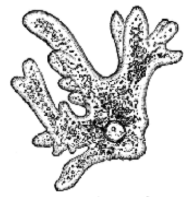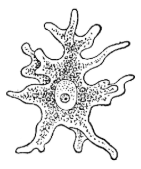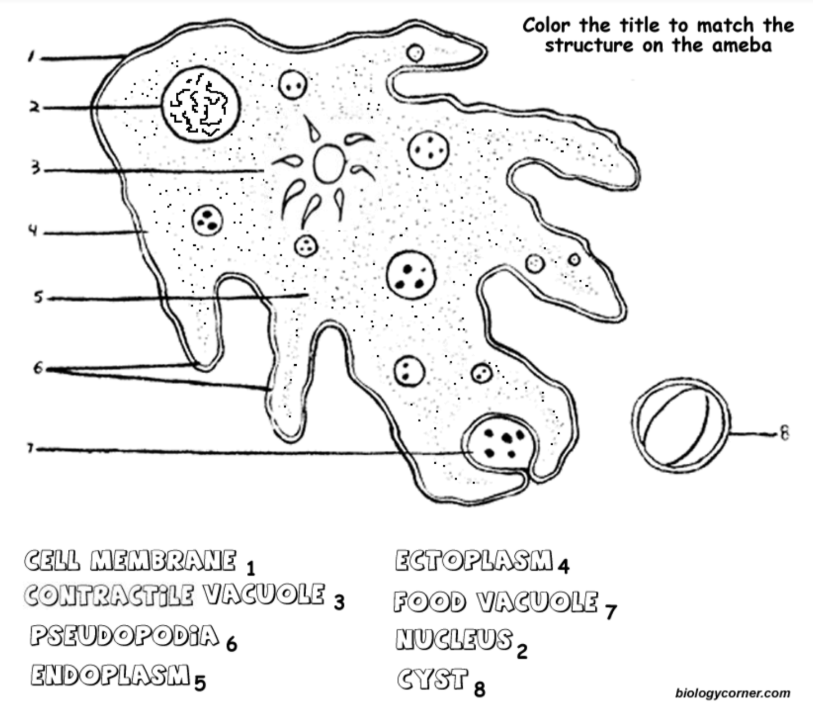Is An Amoeba A Plant Or Animal Cell
Colour the Cellular Structures of the Ameba
- Page ID
- 26990
 The ameba (also spelled amoeba) is a protozoan that belongs to the Kingdom Protista. The name ameba comes from the Greek word "amoibe", which means "alter". Protists are microscopic unicellular organisms that don't fit into the other kingdoms. Some protozoans are considered institute-like, such every bit algae, and others are considered animal-like. The ameba is considered an animal-like protist because it moves and consumes its food, but it is not classified as an animal because information technology consists of a unmarried jail cell; it is unicellular.
The ameba (also spelled amoeba) is a protozoan that belongs to the Kingdom Protista. The name ameba comes from the Greek word "amoibe", which means "alter". Protists are microscopic unicellular organisms that don't fit into the other kingdoms. Some protozoans are considered institute-like, such every bit algae, and others are considered animal-like. The ameba is considered an animal-like protist because it moves and consumes its food, but it is not classified as an animal because information technology consists of a unmarried jail cell; it is unicellular.
Protists are likewise classified by how they move, some take cilia or flagella, only the ameba has an unusual mode of creeping along by stretching its cytoplasm into fingerlike extensions called pseudopodia. The word "pseudopodia" ways "false foot". On the coloring sheet, there are several pseudopodia, use a yellow highlighter or pencil to highlight each of them . When looking at ameba under a microscope, an observer will run into that no ameba looks the same as any other, the cell membrane is very flexible and allows for the ameba to modify shape. Color the jail cell membrane blood-red . Amebas live in ponds or puddles, and tin can even live inside people.

There are ii types of cytoplasm in the ameba, the darker cytoplasm toward the interior of the protozoan is chosen endoplasm, and the clearer cytoplasm that is found near the jail cell membrane is called ectoplasm. On the coloring, the endoplasm is indicated past the dotted area, and the ectoplasm by the white surface area. Color the endoplasm bluish , and go out the ectoplasm uncolored. By pushing the endoplasm toward the cell membrane, the ameba causes its body to extend and pitter-patter along. It is besides past this method that the ameba consumes its nutrient. The pseudopodia extend out and wrap around a food particle in a process telephone call phagocytosis. The engulfed food then becomes a nutrient vacuole. In that location are several food vacuoles on the drawing – color each brown . The nutrient volition eventually exist digested by the cell's lysosomes.
Also visible in the ameba is the nucleus, which contains the ameba's DNA. Color the nucleus royal . In order to reproduce the ameba goes through mitosis, where the nucleus duplicates its genetic textile and the cytoplasm splits into two new daughter cells, each identical to the original parent. This method of reproduction is called binary fission. Another structure easily seen in the ameba is the contractile vacuole, whose job is to pump out excess water and then that the ameba does not burst. Color the contractile vacuole orange.
During unfavorable conditions, the ameba can create a cyst, this hard-walled body can be for a long period of time until conditions get favorable again. At this point information technology opens upward and the ameba emerges. Oftentimes cysts are created during cold or dry periods where the ameba could not survive in its normal condition. Color the cyst green.
Amebas tin can cause affliction. A mutual disease caused past the ameba is called Amebic Dysentery. A person becomes infected by drinking contaminated water. The ameba then upsets the person's digestive system and causes cramps and diarrhea. A person is most likely to be infected in countries where the h2o is not filtered or purified.

Questions:
- How does an ameba motion?
- What structure contains the ameba'south Dna?
- How does an ameba reproduce?
- How does an ameba survive when weather condition become unfavorable?
- What are extensions of the cytoplasm which are used for movement called?
- What illness is caused by the ameba?
- To what Kingdom does the ameba belong?
- How are protozoans classified?
- Why is the ameba non classified as an beast (in the brute kingdom)?
- Why is this unicellular organism called an "ameba?
Source: https://bio.libretexts.org/Learning_Objects/Worksheets/Book%3A_The_Biology_Corner_(Worksheets)/Cell_Biology/Color_the_Cellular_Structures_of_the_Ameba
Posted by: joachimpaus1946.blogspot.com

0 Response to "Is An Amoeba A Plant Or Animal Cell"
Post a Comment